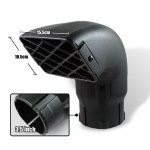I doubt there's any ram air effect at all to these.
Years ago, a car magazine (I've looked all over and can't find it) did a test of a bunch of Sixties/Seventies musclecars (like Mopar Air Grabber/Ramcharger, Chevy Cowl Induction, Ford/Mopar Shaker, etc.) functional cold air systems and found none of them did anything until about 80mph (and most of them did nothing at all, due to the dead air zone/boundary layer/etc.).
Not many deuces going 80, unless the parachute fails after they were jettisoned from a C5.
Good point. I like 2 things about them: the ability to gather intake air above & away from the dust generated by the moving vehicle, and their higher CFM. I'm already noting a restriction with the stock Deuce mushroom intake cap, I hope to solve that with one of the Donaldson intakes caps.
The Aussies really started using these to avoid their filters getting choked up by the Outback's "Bull Dust." Modern 4x4's use them as a "snorkel" in hopes of being able to amphibiously assault the other sides of swollen flood waters (or God knows what). I, along with others here, have heard some pretty fantastic claims about these "snorkels" to assist a vehicle in fording water crossings. I had to have a serious sit-down with my Dad when he almost swamped his Toyota FJ by entering water too fast with his ARB snorkel...I had to remind him about several safety factors in doing something so silly, along with reminding him about other water-crossing factors: breather vents for axles/tranny/transfer case/etc. and the moving engine fan blade through water.
Long story made short is that these intakes have been recently popularized for their Perception Value overwhelming their Performance Value....they are intended to raise the air intake above the dust line to prolong your vehicle's air filter life, while adding more air intake CFM from that "cleaner" air. Most of us here know that its perception as a water-fording device is moot without a raised air intake point, extended breather lines for tranny/axles/transfer case/etc....
And I've also heard the claims that since the "snorkel intake" is now pulling in "cooler" air by being higher away from the pavement, you will see a performance & mileage increase for your engine....HOGWASH. You should see a performance gain if your engine is pulling an intake restriction & you subsequently remove/resolve said restriction...but the air temperature difference is negligible within the first 10-15 feet off the ground.
My current work vehicle has a hood scoop (cowl vent) on it...everyone who looks at it immediately thinks of Mad Max & that I've got some kind of on-off superturbochargerexciter on a stock engine underneath, and want to take a look at it; they're immediately disappointed when I raise the hood to show a totally stock engine compartment. Which leads to the now-tired explanation of ground heat in the desert in the summertime: the ground is typically 165-180 degrees (on average) in July & August afternoons, which the car is sitting right next to...since heat travels upward, what better way to vent that engine/brakes heat generated by a car driven hard than to allow it to continue on its upward journey, instead of trapping it against the underside of the hood? It helps, but it's not a cure-all...it allows us to drive for an extra 10 or 15 minutes hard in the summertime, in case we have a slow-learning or difficult student & need those few extra minutes for them to learn. Then it overheats like normal vehicles & we have to do cool-down loops at slow to moderate speeds to cool the engine/tranny/brakes.
So, like Clinto said, there is no performance gain from the "Ram Air Effect" while driving, other than the 2 purposes it was intended for: raise your air intake above the dust line generated by the moving vehicle & the increase in CFM.




